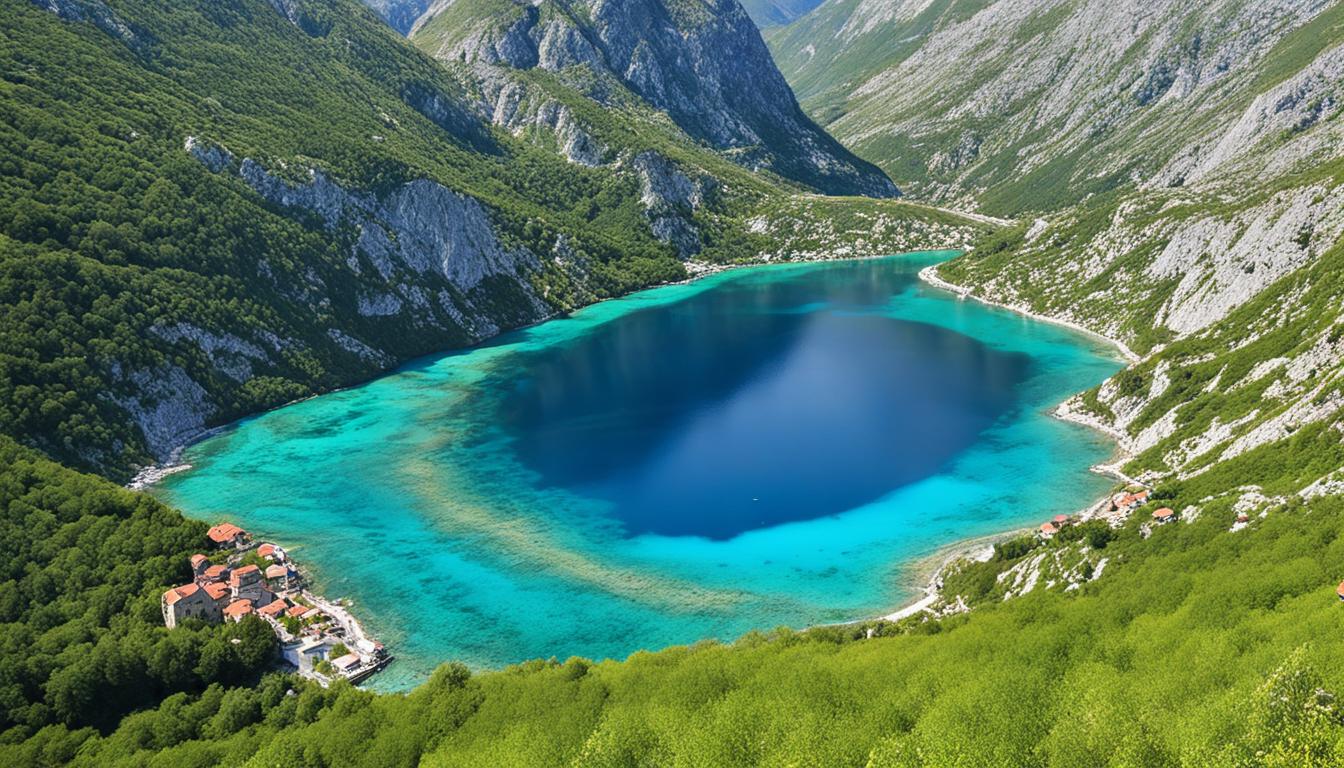Mongolia Sacred Natural Sites and Biodiversity
Did you know that sacred natural sites (SNS) are recognized as the oldest form of habitat protection in human history? It’s true! SNS have been revered and worshipped for centuries, contributing to the preservation of natural environments and wildlife. In Mongolia, the tradition of worshipping sacred mountains has played a crucial role in the conservation of their unique biodiversity. Let’s explore the fascinating world of Mongolia’s sacred natural sites and the importance of their preservation.
Key Takeaways:
- Mongolia has a rich tradition of worshipping sacred mountains, which has contributed to the preservation of natural environments and wildlife.
- Sacred natural sites have a positive effect on biodiversity conservation across continents and geographical settings.
- Sacred natural sites in Mongolia encompass a variety of natural features, including single trees, rock outcrops, rivers, mountains, islands, and entire landscapes.
- Mongolia has designated certain sacred mountains as State Sacred Mountains, which receive official protection and are worshipped by the state.
- Efforts are being made to protect and safeguard sacred natural sites in Mongolia through international assistance projects and collaboration between the government, local communities, and international organizations.
Importance of Sacred Natural Sites
Sacred natural sites (SNS) in Mongolia play a crucial role in the conservation of biodiversity. As protected areas face limitations in halting the current biodiversity crisis, complementary measures such as SNS become important in achieving Mongolian sustainable development. These sites are independent of protected areas and often overlap spatially with them, creating a network of interconnected conservation areas.
Mongolia has a rich tradition of worshipping sacred sites, which has contributed to the preservation of natural environments and wildlife. The worship of sacred mountains in Mongolia has specific customs and rituals that have been preserved for centuries, forming Mongolian eco-friendly practices. This deep-rooted cultural connection to the natural world has fostered a strong sense of stewardship and respect for the environment, driving efforts to conserve and protect sacred natural sites.
Types of Sacred Natural Sites in Mongolia
Sacred natural sites in Mongolia encompass a variety of natural features, including single trees, rock outcrops, rivers, mountains, islands, and entire landscapes. The majority of SNS in Mongolia are sacred groves and forest patches. Some SNS also include built features such as temples, shrines, or monasteries surrounded by natural or semi-natural areas. Mongolia has over 1000 sacred sites, with each site having its own specific customs and rituals associated with it. The worship of sacred mountains is a key aspect of the Mongolian tradition.
These sacred natural sites, found throughout Mongolia, are an essential part of the country’s natural heritage. They provide not only a spiritual connection to the land but also serve as important conservation areas for the unique biodiversity found in Mongolia’s diverse landscapes.
One of the prominent types of sacred natural sites in Mongolia is the sacred grove, which consists of a stand of trees protected for their cultural and ecological significance. These groves are often located in areas of high importance to local communities, serving as gathering places for religious ceremonies and practices.
In addition to sacred groves, Mongolia also has sacred mountains that hold great importance in the tradition of worshipping sacred sites. These mountains are considered sacred and are revered for their beauty and spiritual significance. They often have their own customs and rituals associated with them, passed down through generations.
Another type of sacred site found in Mongolia is the sacred river. These rivers are believed to have special powers and are revered as sources of life and purity. They are often protected and preserved to maintain their spiritual and ecological significance.
The diversity of sacred natural sites in Mongolia reflects the deep connection between the Mongolian people and their natural environment. These sites play a vital role in the conservation of Mongolia’s unique landscapes and biodiversity, contributing to the ongoing efforts of sacred Mongolian landscapes conservation.
Protected Sacred Natural Sites in Mongolia
Mongolia takes great pride in its sacred mountains, designating certain peaks as State Sacred Mountains to receive official protection and reverence from the nation. These sacred mountains include Otgontenger, Eej Khairkhan, Khanbayanzurkh, Great Bogd, Altan Ovoo, and Sutai Khairkhan. Not only do these sites hold immense cultural value, but they also play a crucial role in the conservation of biodiversity.
The State Sacred Mountains in Mongolia serve as important habitats for rare and endangered species, contributing to Mongolian biodiversity protection efforts. They function as key migration corridors for large mammals, allowing these majestic creatures to traverse vast distances and maintain their population connectivity. The conservation of these sacred sites ensures the preservation of vital ecosystems and safeguards the delicate balance of Mongolian wildlife.
“The protection of sacred mountains in Mongolia is a testament to our commitment to environmental conservation efforts. It signifies our recognition of the invaluable ecological services these sites provide,” says Dr. Altansukh Batbold, a leading conservation expert in Mongolia.
Worship rituals and customs associated with these sacred mountains have been officially recognized and deeply ingrained in Mongolian culture. The government holds national-level ceremonies every four years, with the active participation of the President of Mongolia. These rituals not only reinforce the cultural heritage of Mongolia but also symbolize the nation’s dedication to sustainable practices and environmental stewardship.
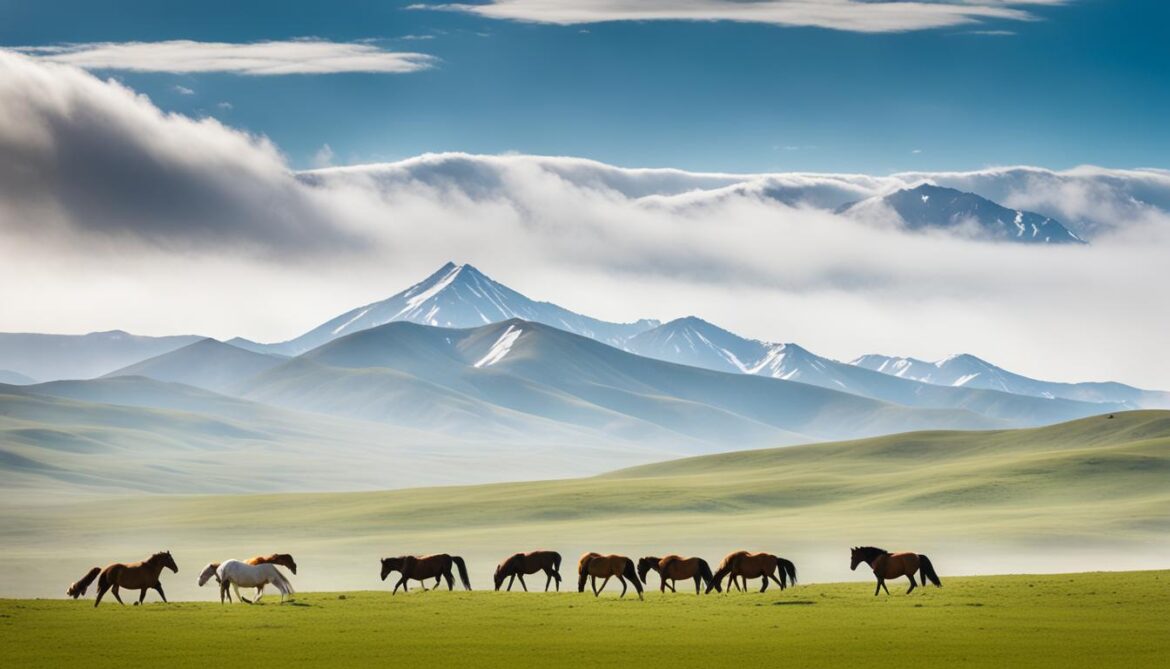
Preserving the Natural and Cultural Heritage
The designation of State Sacred Mountains in Mongolia is a multifaceted approach that values both the cultural and ecological aspects of these sites. By providing official protection, Mongolia ensures the preservation of its natural and cultural heritage for the benefit of present and future generations.
In recognizing the importance of these sacred sites in the context of Mongolian environmental conservation efforts, the government aims to strike a harmonious balance between conservation and cultural practices. Through a collaborative approach involving local communities, government bodies, and international organizations, Mongolia strives to safeguard its sacred natural sites while promoting sustainable development practices.
“The protection of State Sacred Mountains in Mongolia reflects a partnership between humans and nature, harmonizing Mongolian tradition with modern environmental conservation efforts,” affirms Tuya Munkhbat, a local community leader and environmental advocate.
By placing significant attention on the protection of sacred mountains, Mongolia seeks to foster a deep sense of responsibility towards the preservation of natural environments and wildlife. These efforts not only contribute to Mongolian biodiversity protection but also showcase the nation’s commitment to sustainable practices and the promotion of eco-friendly tourism.
Significance of Sacred Mountains in Mongolia
Sacred mountains in Mongolia hold significant importance in the country’s cultural and natural heritage. They are considered to be “combined works of nature and man” and are revered for their spiritual significance. For centuries, these sacred mountains have been protected and worshipped, playing a crucial role in the preservation of Mongolia’s pristine natural environments and wildlife.
One of the key roles of these sacred mountains is their function as refuges for endemic, threatened, rare, or specialist species. These mountains provide a sanctuary for a diverse range of flora and fauna, including species that are unique to the region. The protection and preservation of these sacred sites help safeguard the habitats of these species, ensuring their survival for future generations.
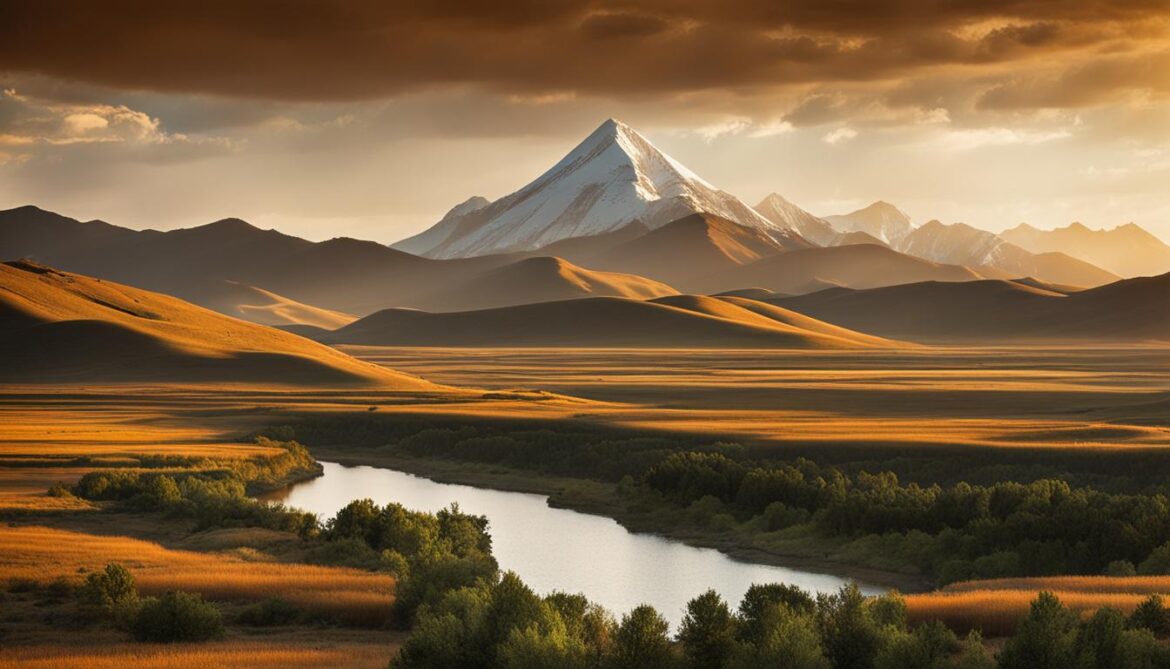
In addition to their ecological significance, sacred mountains also play a vital role in the unique tradition of worshipping sacred sites in Mongolia. This tradition involves various practices such as chanting sutras, sharing folk knowledge, legends, and performing arts. These rituals and customs not only contribute to the cultural heritage of the country but also foster a deep connection between the local communities and the natural world around them.
“Sacred mountains are not merely physical entities; they are an integral part of our identity, carrying the wisdom and memories of our ancestors.”
– Mongolian Elder
The worship of sacred mountains is a testament to the symbiotic relationship between humans and nature in Mongolia. By recognizing these mountains as sacred and preserving their natural environments, Mongolians demonstrate their commitment to both nature conservation and the preservation of their cultural heritage.
As the country continues to embrace sustainable development practices and promote traditional ecotourism, the significance of sacred mountains in Mongolia will remain a cornerstone of conservation efforts. These majestic natural landmarks serve as reminders of the importance of fostering a harmonious coexistence between humans and the natural world, securing a future where both thrive in harmony.
The Role of Sacred Mountains in Biodiversity Conservation
The preservation of sacred mountains in Mongolia not only protects the habitats of diverse species but also contributes to the conservation of larger ecosystems. By safeguarding old-growth trees and forest patches, these mountains help maintain important ecological processes, such as nutrient cycling and carbon sequestration.
Furthermore, the presence of sacred mountains serves as a beacon of hope for the broader conservation movement in Mongolia and beyond. These extraordinary natural features inspire and ignite a sense of responsibility among individuals, communities, and organizations to protect and preserve the natural beauty and biodiversity of our planet.
| Ecosystem Services Provided by Sacred Mountains in Mongolia | Examples |
|---|---|
| Water regulation and purification | Provision of clean water sources downstream |
| Climate regulation | Carbon sequestration and temperature moderation |
| Soil conservation | Prevention of erosion and maintenance of soil fertility |
| Preservation of biodiversity | Habitat for endemic, threatened, and rare species |
| Support for traditional practices | Preservation of cultural rituals and knowledge |
The holistic significance of sacred mountains in Mongolia goes beyond their cultural and ecological roles. They stand as symbols of hope, resilience, and the harmonious coexistence between humans and nature. Through their preservation and continued worship, sacred mountains inspire a deep appreciation for the extraordinary beauty and interconnectedness of the natural world.
Geographical Distribution of Research on Sacred Natural Sites
Research on sacred natural sites has primarily focused on Africa and Asia, with limited studies conducted in other continents. This geographical bias towards Africa and Asia is evident in the research on the effect of Sacred Natural Sites (SNS) on biodiversity conservation. However, it is important to note that the positive effects of SNS on biodiversity have been observed across continents and geographical settings. Despite the current distribution of research, there is a need for further efforts to fill the geographical and taxonomical gaps in our understanding of SNS and to advance knowledge through systematic research.
In order to fully comprehend the global impact of Mongolian sustainable development and the significance of Mongolian natural heritage sites, it is crucial to expand the scope of research beyond Africa and Asia. By conducting studies in diverse geographical regions, we can gain a comprehensive understanding of the positive effects of SNS on biodiversity conservation. This knowledge can then inform sustainable development practices and facilitate the preservation of Mongolian natural heritage sites.
By embracing a more inclusive approach to research, we can uncover valuable insights that may contribute to the broader field of biodiversity conservation. It is important to recognize that each region has its own unique environmental challenges and opportunities, and by conducting research in a variety of settings, we can develop tailored strategies for Mongolian sustainable development and effective conservation of Mongolian natural heritage sites.
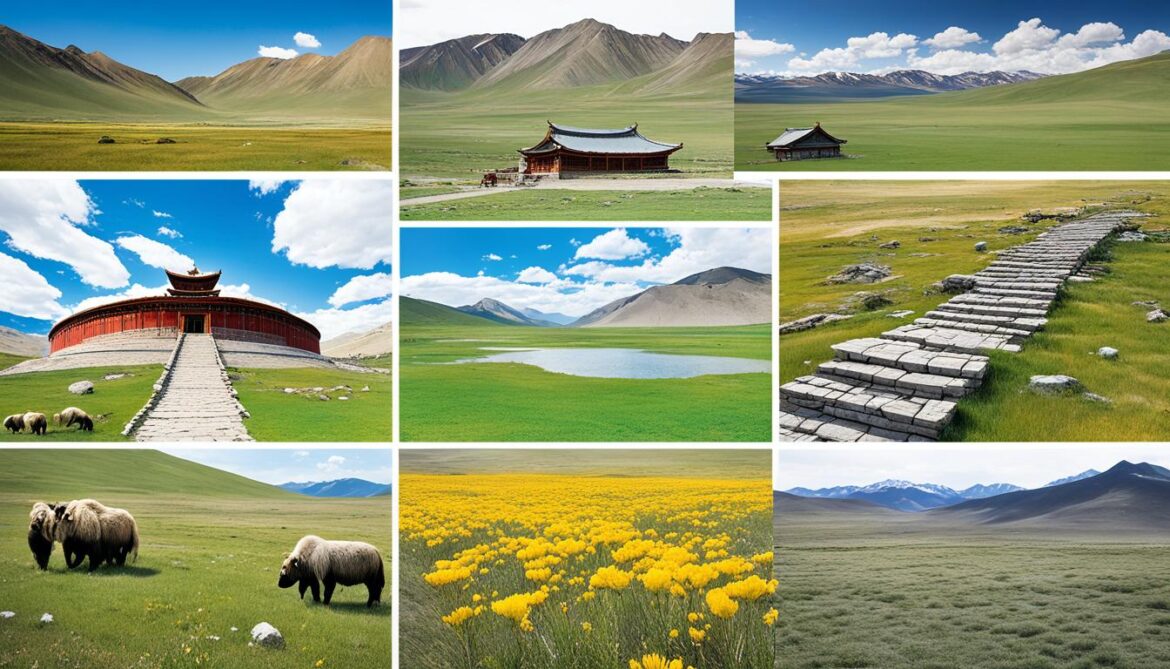
Worshiping Sacred Mountains in Mongolia
The tradition of worshiping sacred mountains in Mongolia is deeply ingrained in Mongolian culture, with its roots dating back to ancient times. Nomadic Mongols hold great reverence for the highest, lofty, and beautiful mountains in their local areas. Throughout history, sacred mountains have been worshiped by Mongolian empires, including the Xiongnu Empire and Chinggis Khaan.
Specific customs and rituals are associated with the worship of these sacred mountains. They include the reading of sutras, the sharing of folk knowledge, and the performance of traditional arts. These rituals serve not only as acts of reverence, but also as a means of protecting the tradition and preserving the natural and cultural heritage of Mongolia.
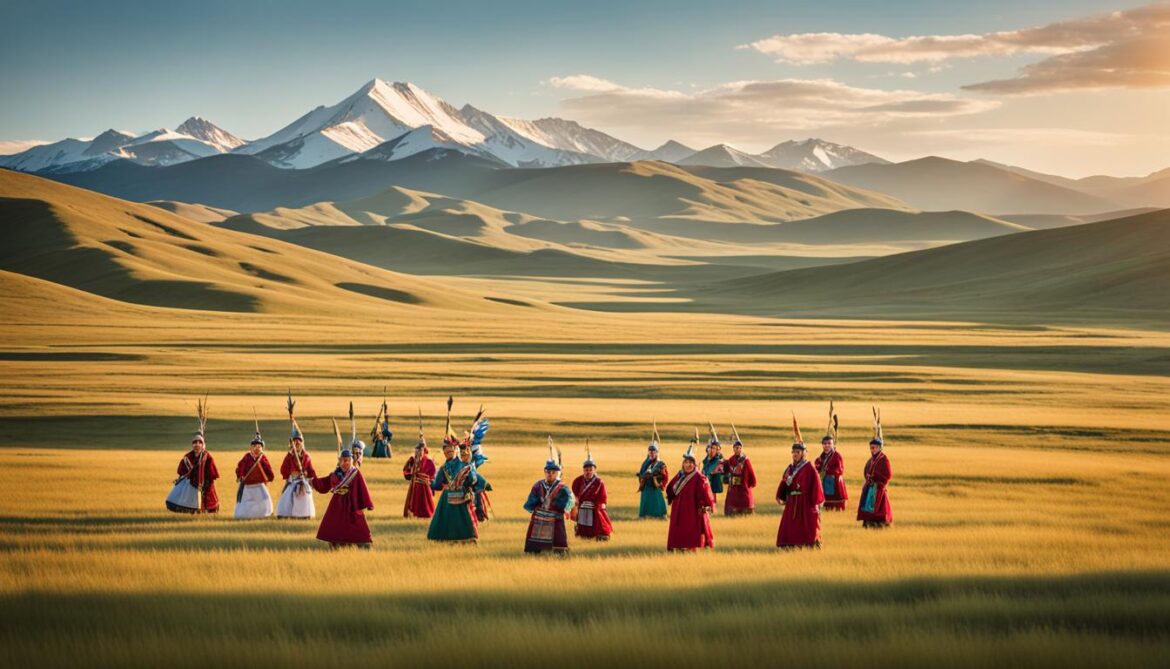
Preserving a Connection to Nature and Spirituality
“The worship of sacred mountains in Mongolia is a profound blend of nature, tradition, and spirituality.” – Mongolian cultural heritage expert
The worship of sacred mountains in Mongolia represents a unique and deep connection between humans, nature, and spirituality. It is seen as a way to honor the natural beauty and grandeur of the mountains while expressing reverence for the spiritual significance they hold. Through their worship, Mongolians strive to maintain this profound connection to their natural surroundings.
Guardians of Ecological Balance
Aside from the cultural and spiritual significance, the worship of sacred mountains also plays a vital role in the conservation of Mongolia’s sacred landscapes. Worshippers recognize the ecological value of these mountains and the critical role they play in preserving biodiversity. The traditions and customs associated with worshipping sacred mountains contribute to the protection of Mongolian flora and fauna, ensuring the conservation of these unique and fragile ecosystems.
The Role of Sacred Mountains in Mongolian Traditional Ecotourism
Worshipping sacred mountains in Mongolia is not only an act of reverence and conservation but is also an integral part of Mongolian traditional ecotourism. Visitors from around the world are drawn to the awe-inspiring beauty of these sacred landscapes. They have the opportunity to immerse themselves in the rich cultural heritage and witness the unique rituals performed by local communities.
This form of ecotourism provides a sustainable way to generate income for local communities while promoting the protection and conservation of the sacred sites. By participating in these eco-friendly practices, tourists contribute to the preservation of Mongolia’s natural and cultural heritage.
The Eco-Spiritual Legacy of Mongolia
Worshipping sacred mountains in Mongolia embodies the interplay between ecological sustainability and spiritual reverence. This unique cultural practice, passed down through generations, has earned Mongolia a reputation as a global leader in the conservation of sacred landscapes. The enduring legacy of this eco-spiritual connection seeks to inspire future generations to ensure the protection and preservation of Mongolia’s sacred mountains for years to come.
| Key Points | Benefits |
|---|---|
| Preservation of natural and cultural heritage | Conservation of sacred landscapes for future generations |
| Promotion of eco-friendly tourism | Sustainable development of local communities |
| Enhancement of biodiversity conservation | Protection of rare and endangered species |
| Maintaining a spiritual connection to nature | Nurturing a sense of reverence and ecological responsibility |
Unique Features of Sacred Mountains in Mongolia
Sacred mountains in Mongolia possess distinctive characteristics that contribute to their significance and make them truly remarkable. These mountains often showcase breathtaking snow-capped peaks, majestic glaciers, and captivating natural formations that have been shaped over millions of years. The diverse landscapes of Mongolia encompass the sacred mountains, ranging from arid deserts to expansive steppe zones and towering mountain ranges.
One of the most remarkable aspects of these sacred mountains is the rich biodiversity they harbor. These mountains serve as a sanctuary for a wide range of flora and fauna, including endangered and rare species. The protection and preservation of these sacred mountains play a vital role in Mongolian biodiversity protection efforts.
Alongside their natural features, some of these sacred mountains boast culturally significant elements. Many sites are adorned with wooden temples and statues, adding to their cultural and heritage value. These sacred mountains hold deep spiritual significance for the local communities, making them integral to Mongolian eco-friendly practices.
Let us now delve deeper into the unique characteristics of sacred mountains in Mongolia. The table below highlights some notable features and species found in various sacred mountains:
| Sacred Mountain | Natural Features | Notable Species |
|---|---|---|
| Otgontenger | Snow-capped peak, glacial lakes | Siberian ibex, snow leopard |
| Eej Khairkhan | Rolling hills, unique rock formations | Bearded vulture, Altai snowcock |
| Khanbayanzurkh | Granitic rock outcrops | Cinereous vulture, Mongolian ground jay |
| Great Bogd | Spectacular views, forested landscapes | Red deer, Mongolian gazelle |
| Altan Ovoo | Golden rock formations, steppe landscapes | Saker falcon, Mongolian toad-headed agama |
| Sutai Khairkhan | Rocky cliffs, ancient burial sites | Long-eared hedgehog, Asiatic wild ass |
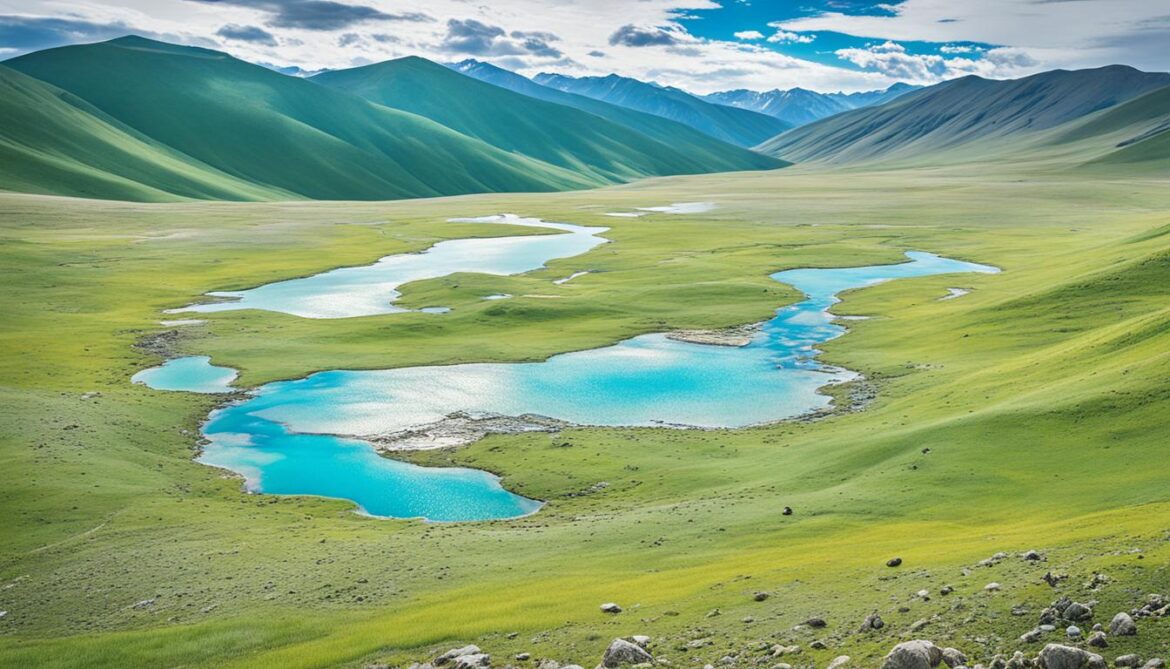
These unique features and the delicate ecological balance within sacred mountains emphasize the importance of their protection and worship in Mongolia. Preserving the natural environment, safeguarding biodiversity, and upholding the cultural significance of these mountains are integral aspects of Mongolian environmental conservation efforts.
Conservation Challenges and Efforts
Despite the cultural and ecological significance of sacred mountains in Mongolia, there are several conservation challenges that need to be addressed. During the communist regime in Mongolia, the practices of worshipping sacred sites were weakened. This led to a decline in the traditional customs and rituals associated with sacred mountains.
Today, some sacred sites in Mongolia face threats such as land degradation, illegal mining, and illegal hunting. These activities pose a significant risk to the natural environments and wildlife that depend on these sacred mountains for survival.
However, the Mongolian government and local communities are actively involved in the conservation of sacred mountains and the protection of their natural landscapes. They have recognized the need to preserve these unique cultural and natural heritage sites for future generations.
Efforts have been made to raise awareness among the broader population, with a specific focus on engaging the youth in environmental conservation efforts. Educational programs and campaigns have been launched to highlight the importance of sustainable practices and eco-friendly behaviours in preserving Mongolia’s natural resources.
International assistance projects have also played a crucial role in supporting the conservation of sacred mountains in Mongolia. These projects aim to revitalize traditional practices, transmit knowledge about sacred sites, and strengthen safeguarding measures.
The revitalization and transmission of traditional practices have led to strengthened safeguarding measures and the protection of sacred sites.
By collaborating with international organizations and drawing on their expertise, Mongolia is able to implement effective strategies for the protection and preservation of sacred mountains. The government’s commitment to conservation and the active participation of local communities create a strong foundation for ongoing efforts.

Conservation Challenges
| Challenge | Impact |
|---|---|
| Weakening of traditional practices | Decline in customs and rituals associated with sacred sites |
| Land degradation | Loss of biodiversity and habitat degradation |
| Illegal mining | Destruction of natural landscapes and pollution |
| Illegal hunting | Threat to wildlife populations |
Conservation Efforts
- Government initiatives to raise awareness and educate the population about the importance of conservation
- Collaboration with international organizations to strengthen safeguarding measures
- Revitalization of traditional practices and customs
- Engaging local communities in conservation efforts
These combined efforts contribute to the protection and preservation of sacred mountains in Mongolia, ensuring the continued existence of these natural and cultural heritage sites for future generations.
International Recognition and Safeguarding Measures
Mongolia’s traditional practices of worshipping sacred sites have gained international recognition. In 2017, they were inscribed on the Urgent Safeguarding List of UNESCO. This acknowledgment highlights the importance of Mongolia’s cultural heritage and its commitment to preserving these sacred sites for future generations.
International assistance projects have been implemented to raise awareness and support the safeguarding of this living heritage. These projects aim to document and protect the traditional practices associated with sacred sites in Mongolia, ensuring their continuity and sustainable development.
“The recognition of Mongolia’s sacred sites as part of the Urgent Safeguarding List demonstrates their global significance. It is a testament to the country’s environmental conservation efforts and commitment to sustainable development.”
Expeditions were organized to identify sacred sites and document the traditional practices carried out at these locations. Through on-the-ground research and engagement with local communities, valuable insights were collected, providing a comprehensive understanding of the cultural and ecological importance of these sites.
The involvement of the Mongolian government and the recognition of some sacred sites as World Heritage Convention lists have created favorable conditions for the safeguarding of these practices. This recognition encourages collaboration between national and international entities to ensure the preservation and promotion of Mongolian natural heritage sites.
The impact of these efforts goes beyond preservation. Documentary films, TV series, and informative materials have been produced to further raise awareness and encourage the protection of this unique cultural heritage. By sharing stories and experiences associated with these sacred sites, a broader audience can appreciate their value and contribute to their long-term conservation.
By leveraging international recognition and safeguarding measures, Mongolia is taking significant strides towards sustainable development and environmental conservation. These initiatives not only protect Mongolian natural heritage sites but also contribute to the broader global effort to preserve our planet’s biodiversity and cultural diversity.

The Importance of International Collaboration
International collaboration plays a crucial role in safeguarding Mongolia’s sacred sites and promoting sustainable development. By sharing knowledge, resources, and best practices, different countries can learn from one another and develop effective strategies for the conservation of natural and cultural heritage.
In addition to government collaboration, partnerships with non-governmental organizations and academic institutions further enhance the efforts to protect Mongolia’s sacred sites. These collaborations facilitate research, conservation projects, and community engagement, ensuring a holistic approach to safeguarding these invaluable locations.
The Future of Mongolia’s Sacred Sites
The international recognition and safeguarding measures surrounding Mongolia’s sacred sites provide a solid foundation for their long-term preservation. With continued collaboration and active participation from local communities, the future of these sites looks promising.
Mongolia’s traditional ecotourism practices, rooted in the worship of sacred sites, can contribute to sustainable development while preserving the country’s cultural and natural heritage. By promoting responsible tourism and educating visitors about the sacred significance of these sites, both locals and tourists can enjoy a meaningful and immersive experience that supports the conservation efforts.
The ongoing commitment to safeguard Mongolia’s sacred sites reflects the country’s dedication to environmental conservation and sustainable development. By protecting these sites, Mongolia not only preserves its rich cultural history but also ensures the survival of unique ecosystems and the species that call them home.
Future Prospects and Collaboration
The future prospects for the conservation of sacred natural sites in Mongolia are promising. The recognition and international support for the safeguarding of traditional practices provide a solid foundation for further collaboration.
The involvement of local communities, government bodies, and international organizations will be essential in implementing sustainable development practices that integrate the protection of sacred sites and biodiversity conservation. Collaborative efforts will ensure the preservation of Mongolia’s unique natural and cultural heritage.
“The involvement of local communities is crucial for the sustainable conservation of sacred natural sites. By working together with government bodies and international organizations, we can create a strong network that ensures the long-term protection of these valuable sites,” says Dr. Batkhishig, a leading researcher in Mongolia’s ecological conservation.
Promoting Traditional Ecotourism
In order to support the conservation efforts, promoting traditional ecotourism can be a viable option. This form of tourism allows visitors to experience the beauty of Mongolia’s sacred sites while respecting the local culture and environment.
By sharing knowledge, rituals, and cultural practices associated with sacred sites, tourism can contribute to both local livelihoods and the protection of these unique natural and cultural heritage sites. This sustainable approach to tourism ensures economic benefits for local communities while minimizing negative impacts on the environment.
Collaboration for Sustainable Development
Collaboration among stakeholders is crucial in achieving sustainable development goals. Local communities, government bodies, and international organizations need to work hand in hand to develop and implement effective strategies for the conservation of sacred natural sites.
Through capacity building programs, workshops, and knowledge exchange initiatives, collaboration can foster the sharing of best practices and innovative solutions. This collective effort will help ensure the long-term preservation of Mongolia’s sacred sites and foster sustainable development that benefits both nature and society.
| Benefits of Collaboration for Sacred Natural Sites Conservation | Benefits for Stakeholders |
|---|---|
| Enhanced protection of sacred sites and biodiversity | Increased tourism revenue and job opportunities |
| Preservation of cultural heritage and traditions | Improved livelihoods for local communities |
| Exchange of knowledge and best practices | Strengthened partnerships and international recognition |
| Development of sustainable tourism practices | Conservation of ecosystem services and natural resources |
Conclusion
Sacred natural sites in Mongolia hold immense cultural and ecological value. The tradition of worshipping sacred mountains has played a significant role in the preservation of natural environments and wildlife. Research has demonstrated the positive effects of these sites on biodiversity across continents and geographical settings. To protect and safeguard these sites, there have been concerted efforts through international assistance projects and collaboration between the government, local communities, and international organizations.
Looking ahead, the future prospects for the conservation of sacred natural sites in Mongolia are encouraging. There is great potential for the implementation of sustainable development practices that integrate the protection of these sacred sites with biodiversity conservation. By promoting responsible and eco-friendly practices, such as sustainable tourism, we can ensure the preservation of Mongolian biodiversity and the continuation of traditional cultural practices associated with these sacred sites.
The preservation of Mongolian biodiversity, through the protection of sacred natural sites, is crucial for the long-term sustainability of the country’s unique ecosystems. It is a collective responsibility to support the ongoing efforts to protect Mongolian wildlife and preserve these important cultural and natural heritage sites. By valuing and conserving our natural resources, we can contribute to a sustainable future for Mongolia and the well-being of its people.





